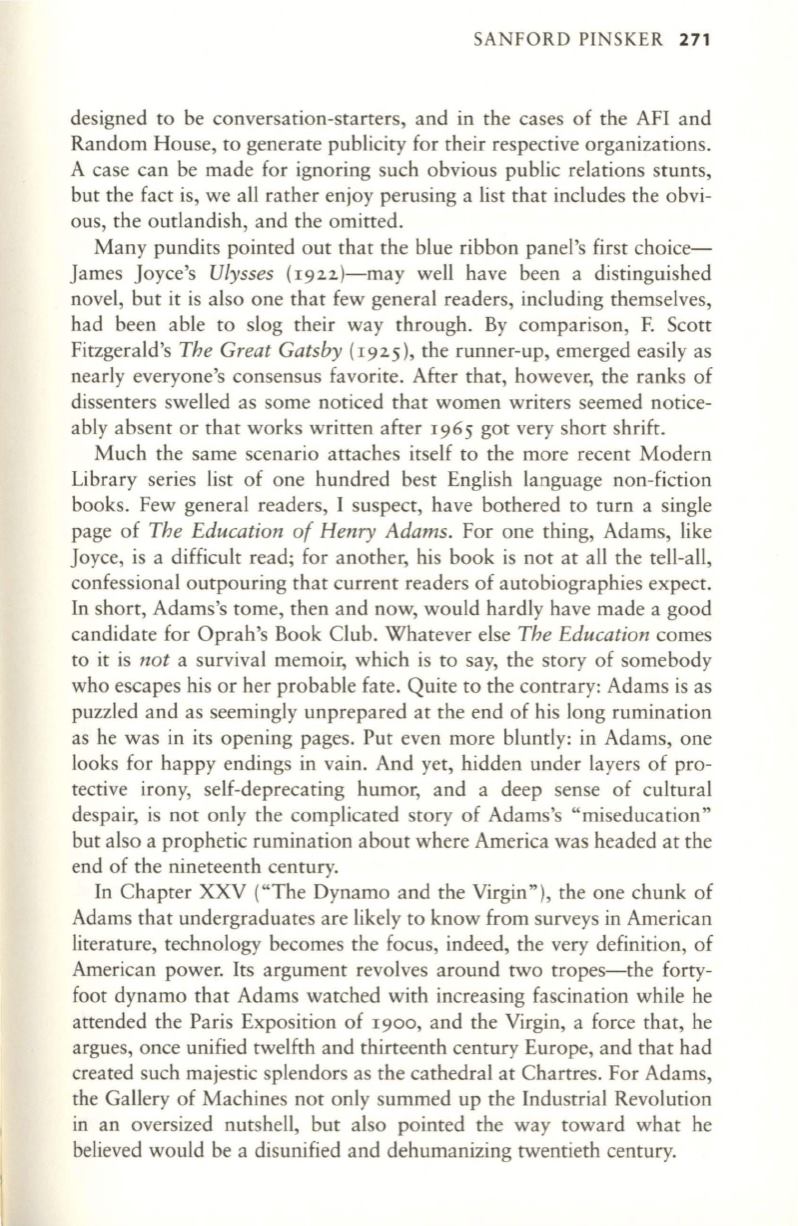
SANFORD PINSKER
271
designed to be conversation-starters, and in the cases of the AFI and
Random House, to generate publicity for their respective organizations.
A case can be made for ignoring such obvious public relations stunts,
but the fact is, we all rather enjoy perusing a list that includes the obvi–
ous, the outlandish, and the omitted.
Many pundits pointed out that the blue ribbon panel's first choice–
James Joyce's
Ulysses
(1922)-may well have been a distinguished
novel, but it is also one that few general readers, including themselves,
had been able to slog their way through. By comparison,
F.
Scott
Fitzgerald's
The Great Gatsby
(1925), the runner-up, emerged easily as
nearly everyone's consensus favorite. After that, however, the ranks of
dissenters swelled as some noticed that women writers seemed notice–
ably absent or that works written after 1965 got very short shrift.
Much the same scenario attaches itself to the more recent Modern
Library series list of one hundred best English language non-fiction
books. Few general readers, I suspect, have bothered to turn a single
page of
The Education of Henry Adams.
For one thing, Adams, like
Joyce, is a difficult read; for another, his book is not at all the tell-all,
confessional outpouring that current readers of autobiographies expect.
In short, Adams's tome, then and now, would hardly have made a good
candidate for Oprah's Book Club. Whatever else
The Education
comes
to it is
not
a survival memoir, which is to say, the story of somebody
who escapes his or her probable fate. Quite to the contrary: Adams is as
puzzled and as seemingly unprepared at the end of his long rumination
as he was in its opening pages. Put even more bluntly: in Adams, one
looks for happy endings in vain. And yet, hidden under layers of pro–
tective irony, self-deprecating humor, and a deep sense of cultural
despair, is not only the complicated story of Adams's "miseducation"
but also a prophetic rumination about where America was headed at the
end of the nineteenth century.
In Chapter XXV ("The Dynamo and the Virgin"), the one chunk of
Adams that undergraduates are likely to know from surveys in American
literature, technology becomes the focus, indeed, the very definition, of
American power. Its argument revolves around two tropes-the forty–
foot dynamo that Adams watched with increasing fascination while he
attended the Paris Exposition of 1900, and the Virgin, a force that, he
argues, once unified twelfth and thirteenth century Europe, and that had
created such majestic splendors as the cathedral at Chartres. For Adams,
the Gallery of Machines not only summed up the Industrial Revolution
in an oversized nutshell, but also pointed the way toward what he
believed would be a disunified and dehumanizing twentieth century.


